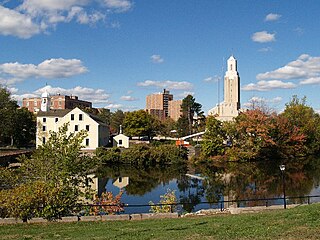
This is a list of properties and districts listed on the National Register of Historic Places in Rhode Island. As of May 29, 2015, there are more than 750 listed sites in Rhode Island. All 5 of the counties in Rhode Island have listings on the National Register.

The Slater Mill is a historic textile mill complex on the banks of the Blackstone River in Pawtucket, Rhode Island, modeled after cotton spinning mills first established in England. It is the first water-powered cotton spinning mill in North America to utilize the Arkwright system of cotton spinning as developed by Richard Arkwright.

This is a list of the National Register of Historic Places listings in Providence County, Rhode Island.
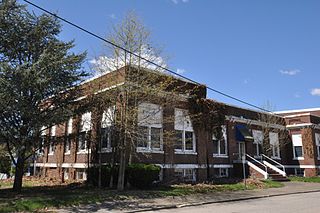
The Richmond Paper Company Mill Complex is an historic American paper mill at 310 Bourne Avenue in East Providence, Rhode Island. It consists of a collection of mainly brick buildings on 13 acres (5.3 ha) of land, bounded on the north by Bourne Avenue, the east by railroad tracks, the west by the Seekonk River, and on the south by land formerly owned by the Washburn Wire Company. The first seven of the surviving buildings were built between 1883 and 1887 by the Richmond Paper Company. The property was acquired at auction in 1894 by Eugene Phillips, who operated the American Electrical Works on the premises, adding further buildings between 1900 and 1930 and demolishing several buildings specific to paper processing. The property presently sees a variety of light industrial uses. The Richmond Paper Company is notable as the place where Arthur Dehon Little started his career.

The Centreville Mill is an historic textile mill at 3 Bridal Avenue in West Warwick, Rhode Island. The mill complex is located on a site that has been used for textile processing since 1794, only four years after Samuel Slater's successful mill operation was established in Pawtucket. The oldest surviving buildings on the east side of the Pawtuxet River date to the 1860s.

The John F. Adams House, listed incorrectly as the John E. Adams House by the National Register of Historic Places, is a historic house at 11 Allen Avenue in Pawtucket, Rhode Island. The house's unique exterior and architecture was described in the multiple property submission which described it as the "finest late Italianate dwelling still standing in Pawtucket." Its design is similar to the dwellings designed by Henry Austin and features Moorish window hoods and Indian porch columns. The John F. Adams House was moved back 50 feet (15 m) and turned to face Allen Avenue after it was purchased by the Beacon Oil Company in 1929. This minor move was found not to make it ineligible because of the house's architectural and historical significance. It was added to the National Register of Historic Places in 1983.

The Conant Thread—Coats & Clark Mill Complex District is a historic district encompassing a large industrial complex which straddles the border between Pawtucket and Central Falls, Rhode Island. This 50-acre (20 ha) industrial area was developed in two phases, with a number of buildings surviving from both of these periods. The first, between 1870 and 1882, resulted in the construction of Mills 2 through 5, a series of large three- and four-story brick buildings which were used in textile manufacturing. A brick office and stables from this period were demolished in 1977, and are the only known brick structures to have been lost. The second phase of construction was between 1917 and 1923, and included the construction of two additional four-story brick mills, a stuccoed recreation hall that has since been converted into a senior center, two two-story brick buildings, and a power plant. This works was first developed by J & P Coats, and became an internationally known source for cotton thread. It was for many years Pawtucket's largest employer.
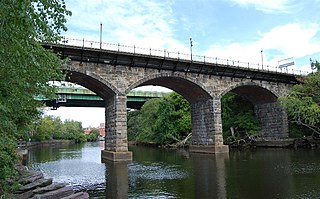
The Division Street Bridge is an historic roadway and sidewalk stone arch bridge in Pawtucket, Rhode Island, carrying Division Street over the Seekonk River. The structure was built in 1875-1877 at a cost of USD$95,000. It is a nine-span stone and brick bridge with a total length of about 450 feet (140 m), making it the "finest and longest" stone arch bridge in the state. It is said to be a symbolic icon of the unity of the two neighborhoods, which are divided by the river, coming together as the Town of Pawtucket. The bridge was listed on the National Register of Historic Places in 1983. Although it may be "functionally obsolete" relative to traffic patterns and in need of repairs, it is considered to be architecturally and historically significant.
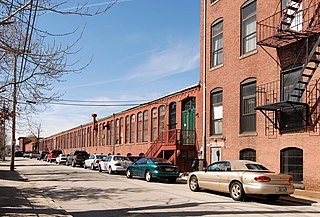
The Hope Webbing Company Mill is a historic textile mill at 999-1005 Main Street in Pawtucket, Rhode Island. The three brick buildings on this 7-acre (2.8 ha) are the surviving elements of what was once a larger complex, extending across Esten Avenue. The oldest portion of the main mill and the boiler house were built in 1889, with the mill growing by numerous additions through 1914. The preparing building was built in 1902 and enlarged in 1913. The Hope Webbing Company was established in 1883, and used these premises to manufacture narrow fabrics using many different types of fibers, including cotton, jute, wool, and silk. The company occupied all or part of the premises until 1994, when it moved its remaining production to Cumberland.

Liberty Arming the Patriot, sometimes called Freedom Arming the Patriot, is a bronze sculpture at Park Place in Pawtucket, Rhode Island, commemorating the participation of the city's citizens in the American Civil War. It was designed by William Granville Hastings and cast by the Gorham Manufacturing Company in 1897. Unlike many Civil War memorials, Liberty Arming the Patriot is a dynamic composition, depicting a young farmer setting his plow aside, and reaching to take a sword from a classical female figure clad in breastplate and wielding a pike. The statue is 11 feet (3.4 m) in height, and is mounted on a granite base 10 feet (3.0 m) high and 22 feet (6.7 m) wide. The sculpture was listed on the National Register of Historic Places in 2001.
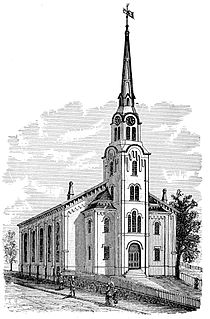
The Pawtucket Congregational Church is an historic church building at 40 and 56 Walcott Street, at the junction of Broadway and Walcott St., in the Quality Hill neighborhood of Pawtucket, Rhode Island.
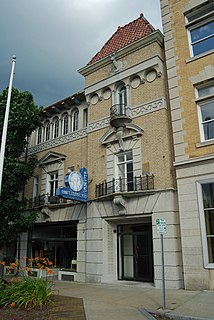
The Pawtucket Elks Lodge Building is an historic site at 27 Exchange Street in the historic central business district of Pawtucket, Rhode Island. The Mission/Spanish Revival building was designed by the O'Malley-Fitzsimmons Company and constructed in 1926. It is three stories in height, with its facade faced in buff brick, laid in Flemish bond, and trimmed in cast stone. Unusual for Elks lodges of the time, the building's first floor was devoted to commercial tenants, with the upper floors devoted to Elks facilities.

The Pawtucket Times Building is an historic site at 23 Exchange Street in the historic central business district of Pawtucket, Rhode Island which is the home of the Pawtucket Times newspaper.

St. Mary's Church of the Immaculate Conception Complex is an historic Roman Catholic church complex at 103 Pine Street in Pawtucket, Rhode Island.
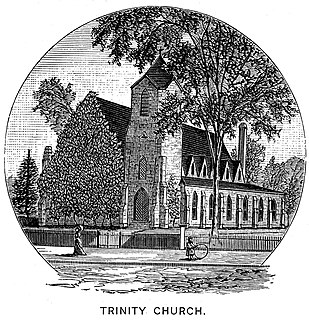
Trinity Episcopal Church was a historic church located at 48 Main Street in Pawtucket, Rhode Island. Built by the Episcopalians, the building was sold to the Catholics in 1977 and became the St. George Maronite Catholic Church within the Diocese of Providence. The church burned down in 2005, and was not rebuilt.

The Standard Paper Box Corporation is a historic industrial complex at 110 Kenyon Street in Pawtucket, Rhode Island. The complex consists of four buildings built between 1914 and 1971, primarily for the purpose of manufacturing boxes for the jewelry industry that was a major economic force in Pawtucket and adjacent Attleboro, Massachusetts. The buildings are notable in the historical development of power systems for industrial facilities, retaining in situ elements of several generations of electro-mechanical power infrastructure. The main building, now a two-story brick structure was built in 1914 by the Standard Paper Box Corporation, which operated on the premises until 1933, enlarging it with a second building in the 1920s. The complex was purchased by Donald Young, Inc., which expanded the premises again, raising the main building from one to two stories, enlarging the second building, and constructing a third in 1939. That company also produced boxes, operating until 1971.

Blackstone River Valley National Historical Park is a National Park Service unit in the states of Rhode Island and Massachusetts. The park was created for the purpose of preserving, protecting, and interpreting the industrial heritage of the Blackstone River Valley and the urban, rural, and agricultural landscape of that region. The Blackstone River Valley was the site of some of the earliest successful textile mills in the United States, and these mills contributed significantly to the earliest American Industrial Revolution. The subsequent construction of the Blackstone Canal, a few years after the successful completion of the Erie Canal, helped to sustain the region's industrial strength.

The Prospect Heights Housing Project is a historic public housing complex at 560 Prospect Street in Pawtucket, Rhode Island. The project consists of 35 brick-faced two-story rowhouses, each containing between 6 and 10 units, and a single-story brick administration building, set on 21 acres (8.5 ha) in the southern part of the city. The complex was developed in 1941-42, with funding assistance from the United States Housing Authority, a New Deal-era housing initiative of the federal government. It is the one of two complexes of this type in the city, and has only seen relatively minor alterations.

The Jenckes Spinning Company is a historic textile factory complex in Pawtucket, Rhode Island. Located on Conant and Weeden Streets, the complex was developed between 1883 and 1919, and was home to the city's largest employer in the 1910s, producing cotton fabric and fabric for use in automotive tires until 1933. The factory complex was listed on the National Register of Historic Places in 2018.
